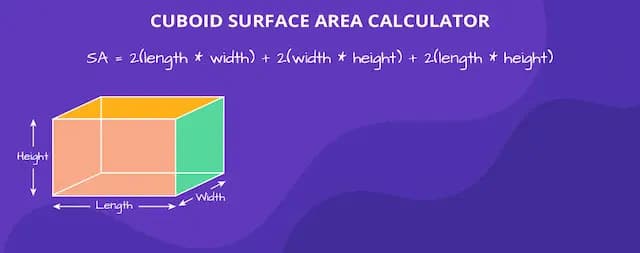
Admissions Open for

Admissions Open for
Cuboid Surface Area Calculator
Cuboid Surface Area Calculator – a powerful tool designed to make calculating the surface area of a cuboid quick and straightforward. A cuboid, also known as a rectangular prism, is a three-dimensional shape with six rectangular faces. Understanding its surface area is crucial in various fields such as mathematics, engineering, and architecture. This tool aims to simplify the process of calculating the cuboid's surface area, providing a valuable resource for students and enthusiasts.
What is the Cuboid Surface Area ?
The surface area of a cuboid refers to the total area of all its six faces. It includes the area of the top, bottom, front, back, left, and right faces of the cuboid.
What is the formula for calculating Cuboid Surface Area ?
The formula for cuboid surface area is:
SA = 2(length*width) + 2(width*height) + 2(length*height)
SA stands for Surface Area.
l represents the length of the cuboid.
w represents the width of the cuboid.
h represents the height of the cuboid.
How is the Cuboid Surface Area Calculated ?
The surface area (SA) of a cuboid can be calculated using the above mentioned formula
Why is the Surface Area of a Cuboid Important to Understand ?
Understanding the surface area of a cuboid is essential for applications such as packaging design, architectural planning, and understanding geometric principles in mathematics and engineering.
Examples
Given: Length (l) = 5 units Width (w) = 3 units Height (h) = 4 units
Calculation:
Using the formula
SA = 2(length*width) + 2(width*height) + 2(length*height)
SA = 2(5*3) + 2(3*4) + 2(5*4)
SA = 30 + 24 + 40
SA = 94 square units
Given: Length (l) = 8 units Width (w) = 6 units Height (h) = 10 units
Calculation:
Using the formula
SA = 2(length*width) + 2(width*height) + 2(length*height)
SA = 2(8*6) + 2(6*10) + 2(8*10)
SA = 32 + 120 + 160
SA = 376 square units
Frequently Asked Questions
The units of cuboid surface area are square units (e.g., square centimeters, square meters).
Yes, it is possible for the surface area of a cuboid to be greater than its volume, depending on the dimensions of the cuboid.
The surface area of a cuboid is crucial in determining material requirements for packaging, paint calculations, and understanding heat transfer in engineering and architecture.
Popular Searches
- NCERT Solutions for Class 1 subjects
- NCERT Solutions for Class 2 subjects
- NCERT Solutions for Class 3 subjects
- NCERT Solutions for Class 4 subjects
- NCERT Solutions for Class 5 subjects
- CBSE School In Aurangabad
- CBSE Schools In Bangalore
- CBSE School In Bhopal
- CBSE Schools In Chennai
- CBSE Schools In Delhi
- Best CBSE Schools In Gurgaon
- CBSE School In Hyderabad
- CBSE School In Indore
- CBSE School In Jabalpur
- CBSE Schools In Jaipur
- CBSE Schools In Kolkata
- CBSE Schools In Mumbai
- CBSE Schools In Nagpur
- CBSE Schools In Pune
- Top CBSE School In Rohtak
- Best CBSE Schools In Sonipat











